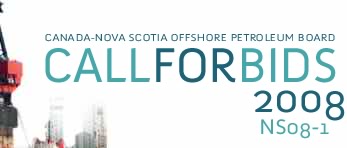



Environmental Protection
Mandate
The Canada-Nova Scotia Offshore Petroleum Board (CNSOPB) is responsible for assuring protection of the environment during offshore oil and gas exploration and exploitation activities in the Nova Scotia offshore area.
Environmental Assessment
The CNSOPB is a federal authority under the Canadian Environmental Assessment Act (CEAA). Under the CEAA, offshore exploration activities require an environmental assessment prior to their authorization. Exploration projects require a screening level of assessment for which the CNSOPB, as a responsible authority and in consultation with other federal authorities, will make an EA decision in accordance with the CEAA. Offshore production projects, however, require completion of a more detailed assessment in the form of a comprehensive study or panel review. All documentation related to environmental assessments conducted under the CEAA can be found on the CNSOPB Public Registry. As well, all projects are registered with the Canadian Environmental Assessment Public Registry.
In the past, the CNSOPB has used class screenings or generic assessments to streamline the regulatory process. These in-depth environmental assessments, usually jointly funded by a number of petroleum companies, have provided detailed overviews of potential environmental effects, and have identified research priorities and mitigation measures beyond the information identified in project-specific environmental assessments. A class screening report for seismic exploration was completed in 1998, and has been used as a reference document for the environmental assessment of individual seismic proposals. Similarly, a generic assessment for exploration drilling on the Scotian Shelf and slope, based on five case studies, was completed in 2000. These assessments are available on the Board’s website: www.cnsopb.ns.ca.
The CNSOPB also conducts Strategic Environmental Assessments (SEAs), which identify environmental issues prior to opening areas for licensing. These issues may be addressed through future project-specific environmental assessments, or they may result in the Board deciding not to accept bids in a particular area. All subsequent projects in an area covered by a SEA, including seismic programs and exploratory wells, still require an environmental assessment prior to project approval. A SEA for the Laurentian Subbasin was completed in conjunction with the Canada-Newfoundland and Labrador Offshore Petroleum Board in 2003. A SEA of Potential Exploration Rights Issuance for Eastern Sable Island Bank, Western Banquereau Bank, the Gully Trough, and the Eastern Scotian Slope was completed in 2003, and a SEA of the Misaine Bank area was undertaken in 2005.
Statement of Canadian Practice with Respect to the Mitigation of Seismic Sound in the Marine Environment (the Statement)
The CNSOPB administers the Statement in the Nova Scotia offshore area. The mitigative measures contained in the Statement were developed based on available scientific knowledge and can be considered to be current best practice for minimizing potential adverse impacts of seismic activities that use air source arrays. It is considered “best practice” during regulatory reviews which include the environmental assessment processes. Operators of seismic operations will be required to provide rationale for any modifications or variations to the mitigative measures that are set out in the Statement for consideration by the CNSOPB. The Statement and a background paper are available at www.dfo-mpo.gc.ca/oceans-habitat/oceans/im-gi/seismic-sismique/index_e.asp.
Environmental Protection Plan / Spill Contingency Plan Requirements
All operators must receive authorization from the CNSOPB prior to conducting any petroleum-related activity in the Nova Scotia offshore area. In support of an application for authorization, the operator is required to submit an environmental protection plan and a spill contingency plan. Proponents are also required to follow the Offshore Waste Treatment Guidelines and the Offshore Chemical Selection Guidelines as part of the environmental protection process. These guidelines have been implemented by the CNSOPB, the Canada-Newfoundland and Labrador Offshore Petroleum Board, and the National Energy Board, and undergo review every 5 years. The Board may impose additional mitigation measures or operating constraints as part of an authorization as a result of the findings of an environmental assessment.
Monitoring of Authorized Work and Activities
The CNSOPB monitors Operator compliance with legislative and regulatory requirements along with any conditions affixed to an authorization by way of site inspections and audits, documentation/record reviews, and interviews at all levels of a proponent’s organization. The Board also conducts investigations into worker complaints, work refusals, accidents, spills and other significant incidents. Part III of the Accord Act delegates authority to the Chief Safety Officer (CSO), the Chief Conservation Officer (CCO), and safety and conservation officers, to conduct these types of activities.
Officers also have the ability to issue orders, including those to cease or limit activities in the event that an unacceptable risk is posed to worker health or safety. Non-compliance is generally addressed through a tiered process that motivates appropriate action from the operator; notwithstanding this, penalties for non-compliance can range up to $1-million per day plus time in jail.
For further information, contact:
Stuart Pinks
Manager, Health, Safety and Environment
Chief Safety Officer
Canada-Nova Scotia Offshore Petroleum Board
6th Floor TD Centre
1791 Barrington Street
Halifax N.S. B3J 3K9
CANADA
Telephone: (902) 422-5588 (24 hour)
Fax: (902) 422-1799